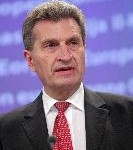 “We must act today to prepare the electricity highways of tomorrow”, urged EU Energy Commissioner Günther Oettinger at a recent conference in Brussels. He also deplored the length of time new grid lines currently take to get approved and built, saying it was “unacceptable”.
“We must act today to prepare the electricity highways of tomorrow”, urged EU Energy Commissioner Günther Oettinger at a recent conference in Brussels. He also deplored the length of time new grid lines currently take to get approved and built, saying it was “unacceptable”.
The Commissioner particularly underlined the need to integrate the offshore wind potential of north-western Europe into an EU-wide power grid.
While stressing the urgent need to act and speed up grid development, Commissioner Oettinger also emphasised the key role of the markets in funding the large majority of the grid upgrades.
 London in Victorian times and beyond was infamous for its thick smog, caused by the extensive burning of coal industrially and domestically, which cloaked the city and made its inhabitants ill. A century or so down the line, the air of Europe’s cities may not be quite so polluted, but we still appear to have a lurking appetite for coal, and a growing appetite for gas.
London in Victorian times and beyond was infamous for its thick smog, caused by the extensive burning of coal industrially and domestically, which cloaked the city and made its inhabitants ill. A century or so down the line, the air of Europe’s cities may not be quite so polluted, but we still appear to have a lurking appetite for coal, and a growing appetite for gas.
In 2010, Europe installed more coal power plants than it decommissioned for the second time in 12 years.[1] EWEA’s 2010 statistics show that while 1,550 MW of coal capacity was taken offline, 4,056 MW were added. Simply put, we added 2.5 GW of coal – the equivalent of about five new power plants.
At a time when the EU rightly prides itself on its leading role in international climate negotiations, its world-class renewable energy industry and forward-thinking climate and energy legislation; when more wind and other zero-carbon power capacity is installed in Europe year on year; when a majority of EU citizens are alarmed by the reality of climate change; it is worrying that we are installing more of the world’s dirtiest, most harmful fossil fuel.
 The power of wind as a positive force was supported on both sides of the Atlantic on Monday with the release of a new survey conducted by a US research firm and an opinion article published in an English newspaper.
The power of wind as a positive force was supported on both sides of the Atlantic on Monday with the release of a new survey conducted by a US research firm and an opinion article published in an English newspaper.
Wind power was seen as either “favourable” or “very favourable” by 75% of people who responded to a Pike Research survey. In addition, wind energy had “unfavourable” responses of only 5%.
The consumer survey, conducted by the Colorado-based firm last summer, canvassed 1,042 Americans on their attitudes and awareness of 12 energy and environmental concepts. The margin of error for the survey results is around 3% with a 95% confidence interval.
 Last week WWF released a major report arguing that the world’s entire energy needs could be met “cleanly, renewably and economically” within four decades.
Last week WWF released a major report arguing that the world’s entire energy needs could be met “cleanly, renewably and economically” within four decades.
Published in conjunction with energy consultancy Ecofys and the Office for Metropolitan Architecture, ‘The Energy Report’ noted there are no technological or financial reasons preventing wind power and other renewables from creating a carbon-free world by 2050.
“If we continue to rely on fossil fuels, we face a future of increasing anxieties over energy costs, energy security and climate change impacts,” WWF Director General Jim Leape said on Thursday in an accompanying press release.
 Over 200,000 people make the European wind industry tick. Who are they and what exactly do they do? Wind Directions met some ’wind workers’ to find out.
Over 200,000 people make the European wind industry tick. Who are they and what exactly do they do? Wind Directions met some ’wind workers’ to find out.
Martin Mortensen spends most of the year out of his home country, Denmark. A commissioning engineer with Suzlon for nearly 11 years, Mortensen’s job involves starting up the newly installed turbines and running tests to make sure everything is fine. He also does update work and trains service staff.
His long time in the industry means he remembers when a 900 kW machine seemed huge, and people said “Wow! We won’t be able to get any bigger than that!” Now he works with Suzlon’s 2.1 MW turbine.
 “We must act today to prepare the electricity highways of tomorrow”, urged EU Energy Commissioner Günther Oettinger at a recent conference in Brussels. He also deplored the length of time new grid lines currently take to get approved and built, saying it was “unacceptable”.
“We must act today to prepare the electricity highways of tomorrow”, urged EU Energy Commissioner Günther Oettinger at a recent conference in Brussels. He also deplored the length of time new grid lines currently take to get approved and built, saying it was “unacceptable”.






 Comments
Comments



